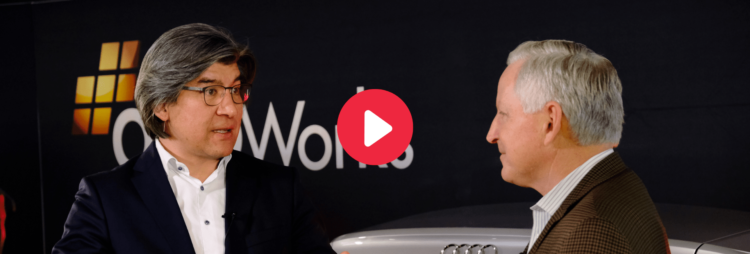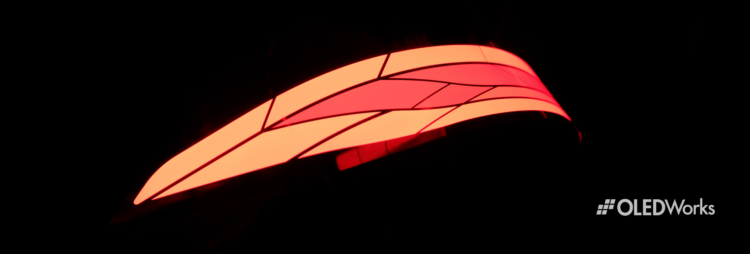![[On-Demand Webinar] Why OLED for Automotive Lighting: The OEM and Tier 1 Supplier Perspectives](https://www.oledworks.com/wp-content/uploads/2022/03/MicrosoftTeams-image-15-750x254.png)
Recently, OLEDWorks moderated a panel of experts from Audi, Valeo Lighting Systems, and Marelli Automotive Lighting in the webinar “Why OLED for Automotive: The OEM and Tier 1 Supplier Perspectives“. During the webinar, the panelists shared lessons learned on their journey of integrating OLED technology into their product roadmaps and answered attendees’ burning questions.
Here are some of the questions that were asked during the live webinar – read on to learn why OLEDs are ideal for automotive lighting, details about the prototyping process, and more.
—
Why is OLED ideal for automotive applications?
OLEDs are ideal for interior and exterior automotive applications where a person needs to directly view the light over a wide range of angles. The panel emission is low in glare, and can be divided into individually addressable, high-contrast segments that allow for communication and unique styling through light.
Can OLEDs be used for brake lighting?
The technology is currently under development for brake, turn, and CHMSL. This will bring all the great benefits of OLEDs, including uniform emission, high contrast segmentation, and the ability to incorporate customized animation and symbology to these functions. It will also enable lighting that combines taillamp and brake into one unit.
Is it possible to use OLED technology in trucks and commercial vehicles?
OLEDs can be used for any vehicle, including trucks, trailers, busses, motorcycles, and motorized scooters.
How does this technology reach cost competitiveness over existing solutions?
OLEDs do not require many components compared to other lighting technologies. For the lighting module integrator, there is less labor of alignment and assembly. In the webinar, Dr. Thomas from Audi mentioned that costs have already decreased by roughly 60% in the last few years, and we expect the price to continue to decrease with further adoption and increased production volume.
What is the typical process, and investment of time and cost for prototyping?
Prototypes for proof of concept can be made in 16 – 20 weeks. Cost depends on the design. We would love to work with you to turn your ideas into a reality! If you wish to learn more about the prototyping process, please reach out to us.
For low volume vehicles, are they a good solution considering the time and cost of development?
With every new vehicle there is an NRE cost. High volume orders allow distribution of the NRE costs over more panels… however, there are multiple ways to address NRE costs and development time for low volume vehicles. Please reach out to us to learn more. Let’s talk about your roadmap and see if OLEDs would be a good fit for you.
Currently this technology caters to the premium segment of vehicles. Can we expect scalability in production and the possibility to take it to mass market vehicles?
OLEDs are a great fit for popular vehicles outside the premium space. As production volume increases, prices will continue to decrease, making OLEDs increasingly affordable for all vehicle segments.
Could we have different surface appearances over OLED?
The surface of the substrate can be modified, and additional films can be placed on the panel. If you have specific ideas and additional questions, please contact us to discuss in more detail.
Has any OLED completed its life on the road?
The typical car lifetime is 15 years, and OLED panels are tested in accelerated environmental testing to reproduce this lifetime. OLEDWorks OLED panels have also passed stringent AEC-Q-102 standards for high temperature and humidity, low temperature, thermal shock, and mechanical shock, demonstrating that they are a reliable light source designed to last the lifetime of the vehicle.
How easy or difficult is the replacement of an OLED panel after the vehicle is on the road?
As with inorganic LED light sources, OLEDs lighting panels are built into the lamp and designed to last the life of the car. No panel replacement is required. If an OLED needs to be replaced, the taillight replacement process is the same as a standard LED taillight.
Can you indicate a minimum depth dimension vs LED/reflectors?
The OLED taillight panels are 1 mm thick and require no more than 25 mm of mounting space. Inorganic LED assemblies will vary with design, are typically 4 to 5 inches (100 mm or greater) deep.
Are there any standard OLED panels that can be purchased for automotive applications without the need for new panel development?
At this time, all of our automotive OLED lighting panels for car programs are custom designs. We do have standard panels available for evaluation, testing, and prototyping. Let’s talk through your ideas and discuss ways to integrate OLED into your roadmap efficiently. If you want to discuss further, please reach out to us – we’d love to hear from you!
—
Missed the webinar? Watch it on-demand and catch up on the exciting discussion!
![[Webinar Q&A] Why OLED for Automotive Lighting: The OEM and Supplier Perspectives](https://www.oledworks.com/wp-content/uploads/2022/05/Webinar-QA-Header-v2-1200x406.png)


